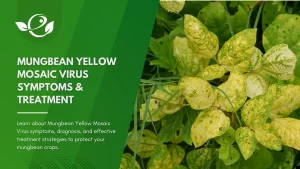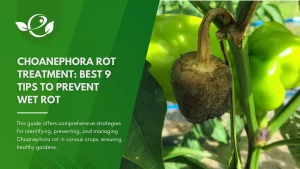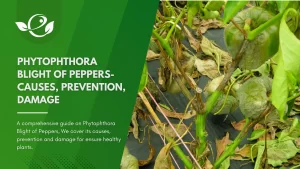Table of Contents
Ah, whiteflies. Those tiny, winged miscreants that seem to revel in turning your garden into their personal playground. If you’ve ever tried to enjoy a peaceful afternoon among your plants, only to find yourself swatting at a flurry of minuscule flying annoyances, you know the frustration. It’s like they’re the uninvited guests at the botanical ball, showing up unannounced and overstaying their welcome. But fear not, intrepid gardener! This guide is here to arm you with all the knowledge and tactics you need to send those pests packing.
Imagine this: your garden, once a serene sanctuary, is now a battleground. The whiteflies, with their tiny, ghostly wings, flutter around like they own the place. They leave behind a sticky mess and bring along their pals, the sooty mold fungi, to further muck things up. It’s like a bad horror movie, but instead of zombies, it’s whiteflies. Luckily, you’re about to become the hero of this story, equipped with a trusty arsenal of prevention and control strategies to reclaim your green kingdom.
So, grab your gardening gloves and get ready to dive into the world of whitefly warfare. This guide will take you through the essential steps of identifying, preventing, and eliminating these pesky invaders, all while keeping your plants healthy and happy. Let’s turn the tables on those tiny tyrants!
What caused it?
Whiteflies are common on a variety of crops grown in open fields and greenhouses. They measure about 0.8-1 mm and have the body and both pairs of wings covered with a white to yellowish powdery, waxy secretion. The eggs are laid on the underside of the leaves. The nymphs are yellow to white, flat, oval and pale green in color. Adult whiteflies cannot live without feeding on a host plant for more than a few days. They are often found on the underside of the leaves, and, if disturbed, will emerge forming a cloud. They thrive in warm, dry conditions. Some whiteflies transmit viruses such as tomato yellow leaf curl virus or cassava brown streak virus.
- It Can also be found in: Banana, Bean, Bitter Gourd, Cabbage, Carrot, Cauliflower, Cherry, Chickpea & Gram, Citrus, Coffee, Cotton, Cucumber, Brinjal, Ginger, Black & Green Gram, Grape, Guava, Lentil, Lettuce, Maize, Mango, Cassava, Melon, Millet, Okra, Onion, Ornamental, Papaya, Peanut, Capsicum & Chilli, Pigeon Pea & Red Gram, Pomegranate, Potato, Pumpkin, Rose, Sorghum, Soybean, Strawberry, Sugar, Beet, Sugarcane, Sweet Potato, Tobacco, Tomato, Turmeric, Zucchini.
Signs and Symptoms of whiteflies
The first step in any battle is knowing your enemy. They are tiny, winged insects that can be hard to spot at first glance. However, they leave behind a trail of destruction that is unmistakable.
- Yellowing Leaves: One of the most common signs of a whitefly infestation is the yellowing of leaves. As whiteflies feed on the sap of plants, they cause the leaves to lose their vibrant green color and turn yellow.
- Stunted Growth: If your plants are not growing as they should, it might be due to a whitefly infestation. These pests drain the essential nutrients from the plants, hindering their growth.
- Sticky Residue (Honeydew): Whiteflies excrete a sugary substance known as honeydew. If you notice a sticky film on your plant leaves or surrounding surfaces, it’s a clear indication of whitefly activity.
- Sooty Mold Development: The honeydew excreted by whiteflies provides a perfect breeding ground for sooty mold, a black fungus that can further damage the plants by blocking sunlight and hindering photosynthesis.

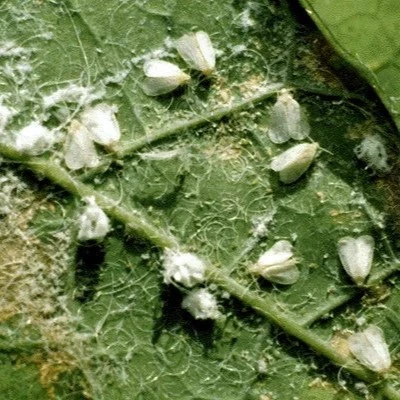
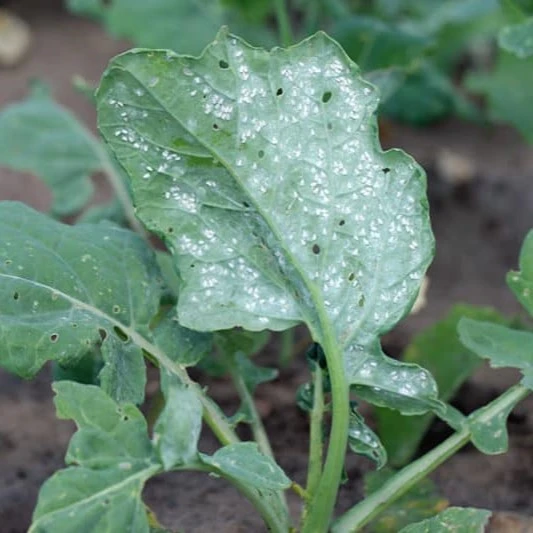
Both adults and nymphs suck the plant sap and excrete honeydew onto leaves, stems and fruits. Chlorotic spots and sooty molds develop on the affected tissues. During heavy infections, these spots may come together and spread over the whole leaf, apart from the area around the veins. The leaves may later become deformed, curl or take a cupping shape.
Preventive Measures
Prevention is always better than cure, especially when it comes to whiteflies. Implementing preventive measures can help you avoid the hassle of dealing with a full-blown infestation.
- Consult with your neighbors and make sure to sow at the right time, not too early nor too late.
- Use denser plant space at planting.
- Watch for signs of whitefly on new purchases or transplants.
- Monitor your field with yellow sticky traps (20/acre).
- Ensure a balanced plant fertilization.
Cultural Practices
- Crop Rotation: Rotate your crops regularly to disrupt the life cycle of whiteflies. They tend to favor certain plants, and rotating crops can help reduce their population.
- Proper Spacing of Plants for Air Circulation: Crowded plants provide an ideal environment for whiteflies. Ensure proper spacing between plants to allow for good air circulation, making it less favorable for whiteflies to thrive.
- Use companion crops that attract or deter whiteflies (nasturtiums, zinnias, hummingbird bush, pineapple sage, bee balm).
- Plant tall-growing plants like maize, sorghum or pearl millet in dense rows as border crops.
- Do not use broad-spectrum insecticides that can affect beneficial insects.
- Remove leaves with eggs or larvae on them.
- Control weeds and alternate hosts in and around the field.
- Remove plant residues from the field or greenhouse after harvest.
- Plan a short fallow at warm temperatures.
Environmental Controls
- Using Reflective Mulch: Reflective mulches can deter whiteflies by confusing them and making it difficult for them to locate their host plants. Aluminum foil or silver-colored plastic mulch works well for this purpose.
- Managing Greenhouse Conditions (Temperature, Humidity): If you grow plants in a greenhouse, maintaining the right temperature and humidity levels can help control whitefly populations. Whiteflies prefer warm and humid environments, so adjusting these factors can make your greenhouse less hospitable for them. UV-absorbing greenhouse plastic films can reduce infestations.
Encouraging Natural Predators
Nature has its own way of controlling pests, and encouraging natural predators can be an effective way to manage whitefly populations.
- Parasitic Wasps: Tiny parasitic wasps, such as Encarsia formosa, lay their eggs inside whitefly nymphs, effectively controlling their population. These wasps can be purchased and released in your garden.
- Ladybugs: These colorful beetles are voracious predators of whiteflies. Introduce ladybugs to your garden to help keep whitefly numbers in check.
- Lacewings: Lacewing larvae are known for their appetite for whiteflies. They can be introduced into the garden as biological control agents.
Non-Chemical Control Methods of Whiteflies
If preventive measures are not enough and you find yourself facing a whitefly infestation, there are several non-chemical control methods you can employ.
- Handpicking: While it may be time-consuming, manually removing whiteflies from your plants can be effective, especially for small infestations. Use a handheld vacuum to suck up the insects, or simply pick them off by hand.
- Spraying Plants with Water: A strong blast of water can dislodge these insects from your plants. Use a garden hose with a spray nozzle to target the undersides of leaves where whiteflies congregate.
- Use of Yellow Sticky Traps: They are attracted to the color yellow. Place yellow sticky traps around your garden to catch and monitor whitefly activity. These traps can give you a good indication of the severity of the infestation.
- Shaking Leaves: Gently shake the leaves of your plants. If whiteflies are present, they will flutter up in a small cloud, making them easier to spot.
15 Natural Treatment Options for Whiteflies
Biological solutions will vary depending on the specific species of whitefly involved and the crop. Natural insecticides based on sugar-apple oil (Annona squamosa), pyrethrins, insecticidal soaps, Neem seed kernel extract (NSKE 5%), Neem oil (5ml/L water) are recommended. Pathogenic fungi include Beauveria bassiana, Isaria fumosorosea, Verticillium lecanii, and Paecilomyces fumosoroseus.
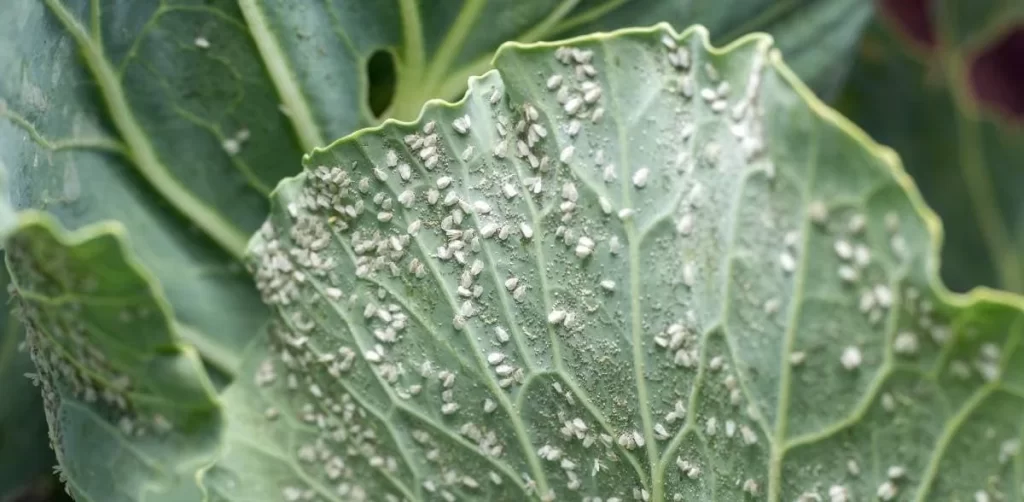
It can be a persistent pest in the garden, but there are numerous natural methods to control and eliminate them without resorting to harsh chemicals. Here are 15 effective natural treatments:
1. Neem Oil
Neem oil is a popular natural insecticide that disrupts the life cycle of these insects. Mix neem oil with water and a few drops of mild liquid soap, then spray it on affected plants. Neem oil is safe for beneficial insects and works by repelling and killing whiteflies.
2. Insecticidal Soap
Insecticidal soap is made from potassium salts of fatty acids. When sprayed on whiteflies, it penetrates their outer shell and causes them to dehydrate and die. Ensure thorough coverage of the leaves, especially the undersides where these insects congregate.
3. Horticultural Oil
Horticultural oil, such as mineral oil or vegetable oil, can smother whiteflies and their eggs. Mix the oil with water and a small amount of soap, then spray it on the infested plants. This treatment is effective and safe for most plants.
4. Garlic Spray
Garlic has natural insecticidal properties. Blend several cloves of garlic with water, strain the mixture, and spray it on the affected plants. Garlic spray repels whiteflies and other pests while being safe for beneficial insects.
5. Companion Planting
Planting certain plants alongside your crops can repel whiteflies. Marigolds, nasturtiums, and basil are known to deter whiteflies. These companion plants can be strategically placed to protect susceptible plants.
6. Reflective Mulch
Reflective mulches, such as aluminum foil or silver-colored plastic, can confuse and repel whiteflies. Place reflective mulch around your plants to deter whiteflies from landing and laying eggs.
7. Yellow Sticky Traps
Whiteflies are attracted to the color yellow. Hang yellow sticky traps near infested plants to capture and monitor whitefly populations. This method helps reduce their numbers and provides an early warning system.
8. Water Sprays
A strong jet of water can dislodge whiteflies from plants. Use a garden hose with a spray nozzle to target the undersides of leaves where whiteflies typically gather. This method is effective for small infestations.
9. Parasitic Wasps
Encarsia formosa is a tiny parasitic wasp that targets whitefly nymphs. These wasps lay their eggs inside the nymphs, killing them as the larvae develop. Introduce these beneficial wasps to your garden to naturally control whitefly populations.
10. Predatory Beetles
Certain beetles, like ladybugs and predatory beetles, feed on whiteflies. Release these natural predators into your garden to help keep whitefly numbers in check.
11. Lacewings
Lacewing larvae, also known as aphid lions, are effective predators of whiteflies. Introduce lacewing eggs or larvae to your garden to control whitefly populations naturally.
12. Diatomaceous Earth
Diatomaceous earth is a natural powder made from fossilized algae. When sprinkled on plants, it damages the exoskeletons of whiteflies, causing them to dehydrate and die. Apply it to the leaves and soil around infested plants.
13. Essential Oils
Essential oils like peppermint, clove, and rosemary can repel whiteflies. Mix a few drops of essential oil with water and spray it on the plants. These oils have insecticidal properties and a pleasant aroma.
14. Homemade Soap Solution
Create a simple soap solution using dish soap and water. Spray the solution on the affected plants, focusing on the undersides of leaves. The soap breaks down the outer layer of whiteflies, causing them to dehydrate.
15. Baking Soda Spray
Baking soda can be used as a natural fungicide and insecticide. Mix a teaspoon of baking soda with water and a few drops of dish soap. Spray the mixture on plants to repel whiteflies and prevent mold growth.
Chemical Control Methods of Whiteflies
In severe cases, chemical control methods may be necessary to get rid of whiteflies. However, these should be used as a last resort and with caution to avoid harming beneficial insects and the environment.
Always consider an integrated approach with preventive measures together with biological treatments if available. Whiteflies quickly develop resistance to all pesticides, so a rotation of different products is recommendable. Apply products based on or combinations of bifenthrin, buprofezin, fenoxycarb, deltamethrin, azadirachtin, lambda-cyhalothrin, cypermethrin, pyrethroids, pymetrozine or spiromesifen to control the insect. Be aware that preventive measures are often enough to reduce the population to harmless levels.
Proper Application
- Timing and Frequency: Apply chemical treatments in the early morning or late evening when whiteflies are less active. Follow the instructions on the label for proper dosage and frequency of application.
- Safety Precautions for Humans and Pets: Wear protective clothing and gloves when applying chemical insecticides. Keep pets and children away from treated areas until the spray has dried.
Integrated Pest Management (IPM)
Integrated Pest Management (IPM) is a holistic approach to pest control that combines multiple strategies for effective and sustainable management.
Overview of IPM Principles
- Combining Multiple Strategies: IPM involves using a combination of cultural, biological, and chemical methods to manage whitefly populations. This reduces reliance on any single method and increases overall effectiveness.
- Monitoring and Decision-Making Based on Pest Thresholds: Regular monitoring of whitefly populations and damage levels helps determine when and what type of control measures are needed. Action is taken only when pest populations reach a level that threatens plant health.
Steps for Implementing IPM
- Regular Monitoring and Record-Keeping: Keep a close eye on your plants and record any signs of whiteflies. Use yellow sticky traps and inspect plants regularly to monitor whitefly activity.
- Combining Preventive, Non-Chemical, and Chemical Methods: Use a combination of preventive measures, non-chemical controls, and, if necessary, chemical treatments to manage whitefly populations effectively.
- Evaluating the Effectiveness of Control Measures: After implementing control measures, assess their effectiveness. Adjust your strategy as needed to ensure long-term control of whiteflies.
Long-Term Management and Prevention
Effective long-term management and prevention require ongoing vigilance and care.
- Continuous Monitoring: Regularly check your plants. Early detection and intervention can prevent small infestations from becoming major problems.
- Seasonal Preparations and Plant Care: Prepare your garden for each season by removing dead plant material, rotating crops, and maintaining healthy soil. Healthy plants are more resilient to pests and diseases.
- Educating Others About Whitefly Management: Share your knowledge and experience with fellow gardeners. Educating others about whitefly management can help prevent the spread of these pests and promote healthy gardening practices.
Conclusion
Healthy plants are more resilient to pests and diseases. Ensure your plants receive adequate water, nutrients, and sunlight. Avoid over-fertilizing, as excessive nitrogen can attract whiteflies and other pests. Promote biodiversity in your garden by planting a variety of species, which can help naturally deter whiteflies and support beneficial insects.
Whiteflies may be tiny, but they can cause significant damage to your plants if left unchecked. By implementing a combination of preventive measures, non-chemical controls, and, if necessary, chemical treatments, you can effectively manage whitefly populations and protect your garden. However, armed with the right knowledge and tools, you can effectively manage and eliminate these pests, ensuring your plants remain healthy and vibrant. Remember, the key to successful whitefly management is early detection and a proactive approach. Stay vigilant, keep your plants healthy, and share your knowledge with others to create a thriving, pest-free garden.
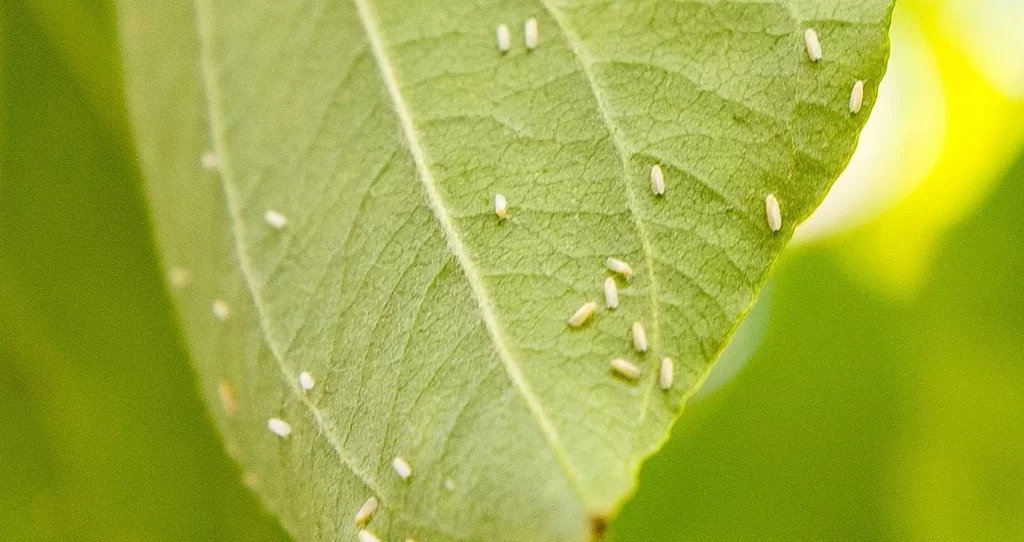
FAQ (Frequently Asked Questions)
What is a natural killer for whiteflies?
Natural predators of whiteflies include:
1. Ladybugs: These beetles consume whiteflies at both larval and adult stages.
2. Lacewings: Lacewing larvae, also known as “aphid lions,” are effective whitefly predators.
3. Parasitic Wasps: Tiny wasps, such as Encarsia formosa, lay their eggs inside whitefly nymphs, killing them as the wasp larvae develop.
4. Predatory Beetles: Some beetles prey on whiteflies, reducing their populations naturally.
How to use neem oil for whiteflies?
Neem oil is an effective natural remedy for whiteflies. Here’s how to use it:
1. Dilute the Neem Oil: Mix neem oil with water according to the product’s instructions. Typically, you might use about 1-2 tablespoons of neem oil per gallon of water.
2. Add a Surfactant: Add a few drops of mild liquid soap to the solution to help the neem oil mix with water and adhere to plant surfaces.
3. Shake Well: Thoroughly mix the solution to ensure even distribution of neem oil.
4. Spray the Plants: Apply the mixture to the affected plants, ensuring to cover the undersides of leaves where whiteflies tend to congregate.
5. Repeat Application: Reapply the neem oil solution every 7-14 days until the whiteflies are under control. Avoid spraying during the hottest part of the day to prevent leaf burn.
Does soapy water work on whiteflies?
Yes, soapy water can be effective against whiteflies. The soap works by breaking down the protective outer layer of the insects, causing them to dehydrate and die. Here’s how to use it:
1. Prepare the Solution: Mix 1-2 tablespoons of mild liquid soap (such as dish soap) with a gallon of water.
2. Spray the Plants: Apply the soapy water to the affected plants, focusing on the undersides of leaves where whiteflies are most likely to be found.
3. Repeat as Needed: Reapply every few days until the infestation is controlled. Be sure to test a small area of the plant first to ensure there is no adverse reaction.
What temperature kills whiteflies?
Whiteflies are sensitive to extreme temperatures. While there isn’t a specific “kill temperature,” sustained temperatures below freezing (32°F or 0°C) can kill whiteflies. Conversely, extreme heat can also reduce their populations, but temperatures would need to be quite high (above 100°F or 38°C) for an extended period to have a significant impact. However, using temperature as a control method is impractical for most gardeners, so integrated pest management strategies are recommended.
Does vinegar get rid of whiteflies?
Vinegar is not a common or recommended method for getting rid of whiteflies. While it can act as a deterrent and might kill some whiteflies on contact, it is also highly acidic and can damage plants if not used correctly. If you choose to use vinegar, it’s important to dilute it heavily and test it on a small area of the plant first. A safer approach is to use more established methods such as neem oil, insecticidal soap, or introducing natural predators.




